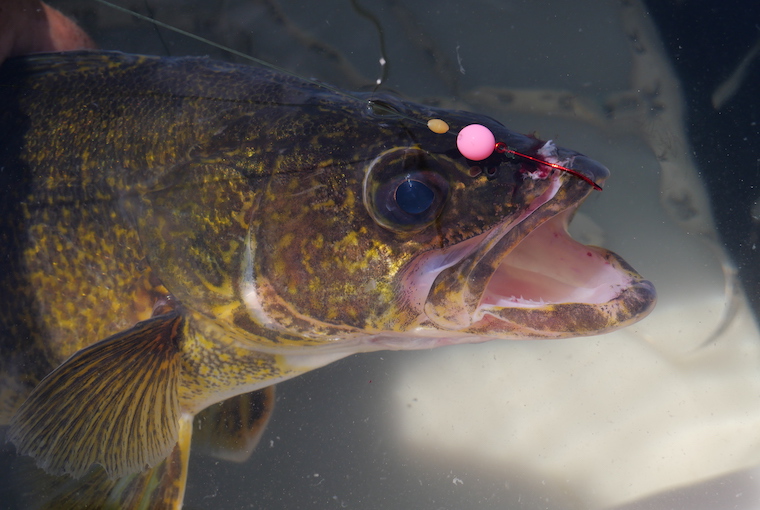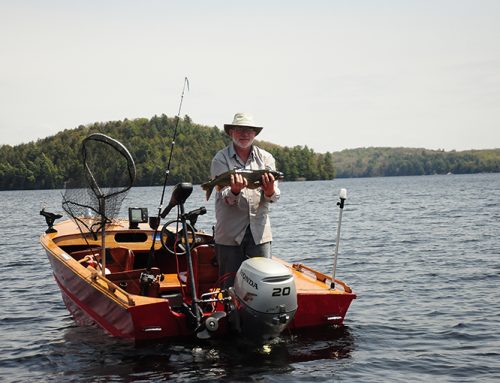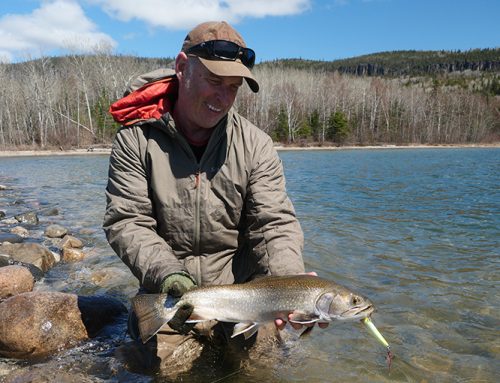
The morning fish had been a tough one. The water looked perfect, and the temperature was right, but hooking a steelhead was proving difficult. I’d tried some egg-pattern flies, an old school yarn fly and a few nymphs, with no takers. Digging through my bag, I came upon a selection of plastic beads. They were mostly translucent shades of green, red, and yellow.
At the time, I’d not really fished much with a bead on its own, but there was nothing to lose. I rigged a chartreuse bead above my hook with a rubber bobber stop. I anchored an inch or so above a #6 octopus hook, with a #3 split shot slinky rig a few feet further up the line. This would allow the bead to drift downstream with the current, just above bottom. In the water, the plastic orb had a very natural look, not unlike a free-floating rainbow egg. I lobbed the rig upstream and followed the running line with the tip of the fly rod controlling the drift. The first drift was uneventful.
However, on the second run, the path of the bead was interrupted. I lifted the tip and a very ornery hen rolled up on the surface and before bolting down the run. I tripped and stumbled trying to keep up, but managed to hold the chrome steelie in the run. After a few minutes, the fish tired and was led to shore. The single bead was lodged in her jaw. That would become the first of many steelhead I’ve caught with a single bead since. And that is just one of the many ways to use this most useful of fishing presentations.
The bead is one of the simplest, cheapest, and most effective fishing accessories you can own. It is deadly as an egg substitute for trout, an attractor on a spinner, or as a dash of colour on a live bait rig.
Let’s look at the wide world of beads and how an Ontario angler can use them.
Glass vs. plastic
The majority of beads used in freshwater angling are plastic, with wide variations of hardness and texture. Glass beads, which are also used, can provide extra weight to a presentation. Glass beads also can have some very unusual shades and colour mixes that look different from plastic. All beads used for fishing have a hole in the centre that allows the line to be threaded through. The size of the hole can vary, depending on what the bead is used for.
Beads for trout and salmon
As I said, beads have become a real go-to for steelhead, trout, and even salmon anglers in recent years. Beads can be fished with fly tackle, drifted with floating gear or centre pinned under a float. There really is no end to what a bead can do as a trout attractant. Single beads look like eggs that are drifting downstream, making them deadly in rivers and current. Many anglers prefer a single bead, but I like to fish a double bed rig with either two different colours or two different sized eggs. (See rigging, page 60 of the Fall 2022 issue.)
In clear water, translucent beads of orange, red, chartreuse or yellow are top picks, but there is a mind-boggling array of colours and shades to choose from. Some milky or opaque beads look like eggs that have been in the river a while or shaken loose from redds (spawning beds). You can also add a bead to a yarn fly or in front of a worm (real or rubber) for a little colour with the meat. A single bead can also be very deadly suspended under a float.
Many steelhead and salmon anglers have discovered that glass beads hang especially well and swing nicely under a float. Keep the bead just off the bottom and you should be in business. Soft beads have become quite the rage and certainly present differently than hard beads. It is hard to argue that a trout biting a soft bead would be less inclined to spit it than a hard bead. However, I have found hard plastic and glass beads can hold their own quite well with the soft ones.
Beads and live bait rigs
I was introduced to the use of bead and live bait rigs more than three decades ago on a lake northwest of Thunder Bay. I’d been invited by local anglers Richard Anderson and the late Bernie Schneiders to try for fall walleye. Their preferred technique was to back troll large chub or sucker minnow via slip sinker rigs or bottom bouncer.
The basic set up was the same for both the slip sinker and bottom bouncer. There was a three or four-foot leader of 10-pound test, with a #1 or #2 Octopus hook. A single plastic bead was placed in front of the hook. The two anglers each had their own theories as to why the bead was important and would choose different colours. It’s long enough ago that I can’t remember who did what and why, but a single glow or chartreuse bead were the two most frequently used choices, with flame red, orange, and yellow also making appearances. To say their simple technique worked on fall walleye would be an understatement and I’ve never looked back.
The bead is an attractor for sure but might also be seen as an insect that was being consumed by the minnow. The plastic bead is also buoyant, something that really came into play when I also started using a single bead in front of worms or leeches. The bead can run free on the leader in front of the hook or be anchored in place. I tend to allow a bead to free range on the leader, which means it may not always be right in front of the hook and bait. I’ve also used double bead set ups for some unique colour mixes and extra buoyancy. There are no rules in this game. Let your eye and success decide what the fish might prefer.
Beads and spinner rigs
Beads are to spinner rigs what mashed potatoes are to pot roast. You really can’t have one without the other. Spinner rigs come in many forms, but the ones I’m talking about are built on a mono-filament or fluorocarbon leader. The spinner rig will have a clevis, blade, snelled hook, and swivel at the end of the leader for attaching to the main line. Yet, it’s the addition of beads that adds that deadly mix of colour, buoyancy, and bulk. You can buy any number of commercial spinner rigs and they will have a variety of coloured bead options.
My preference is to muck around with bead mixes and either customize a pre-tied rig or make them from scratch. Beads are not always perfectly round, in fact they can come in some very unusual shapes. Some of the options can include beads with spikes, bumps, squares, and other oddities. While these funky-shaped beads may not be the best egg imitation, they can add some interest and appeal to a rig. Spinners with muticoloured beads look like jewelry, yet the overall impact of that string of colour and shapes makes for a very appealing presentation behind a spinner.
When tying your own rigs, play with different bead patterns and colour variations. I like to add glow beads to walleye spinner rigs, especially where the fish are in dark water. Keep in mind that glass adds weight to a spinner rig, which can be beneficial if you want to troll shallow without extra weight on the line but not so great if pulled behind a bottom bouncer, where a weighted spinner will more likely grab bottom.
Beads can work wonders in a wide variety of fishing situations. Add them to your bag of tricks and get ready to be dazzled.
Rigging for steelhead
For many Ontario anglers, bead fishing begins and ends with steelhead as it is a proven fish catcher. When fishing a single (or double) bead rig, always use a thin wire #4, #6, or #8 short-shank hook with an upturned eye. This hook is attached with a snell or egg-loop knot. This knot holds the shank in line with your line and provides a direct pull on the hook when a fish strikes. You can anchor the bead with a soft plastic peg, rubber band, or even a toothpick. Rubber bobber stops placed on both sides of the bead allow for easy adjustments of a bead as well. About a two-finger gap between the bead and hook is the standard.
Originally published in the Fall 2022 issue of Ontario OUT of DOORS






Leave A Comment